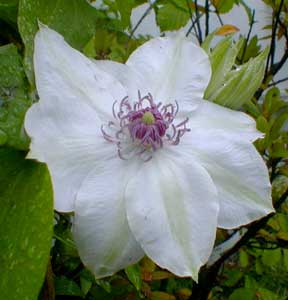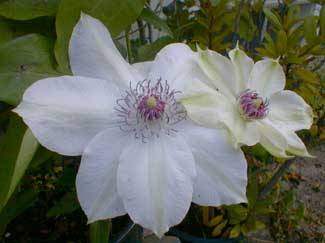
Clematis
'Miss Bateman'
"What floral beauties ye display,
Stars of snowy purity."
'The Clematis"
by Alexander Bathgate
(1845-1930)
by Alexander Bathgate
(1845-1930)
'Miss Bateman' is an heirloom clematis dating to 1869, developed by nurseryman Charles Noble of Surrey, England, from a Clematis patens cross of 'Fortunei' with 'Standishii.' Both of these were spotted by by Robert Fortune growing in Tokyo neighborhoods, who sent them to Charles Noble & John Standish's nursery in the early 1860s. Noble's hybrid was named for Catherine Bateman, the daughter of a famous orchid grower, James Bateman.
Late May to June flowers are six inches wide & extremely numerous on this vine, with a second lesser bloom period in August & September. The blooms begin white with pastel green stripe down the center of each petal. The stripe quickly fades until the large blossom is almost entirely white, though comparison to something really pure white reveals the faintest of faint pink blush. It has a circle or eye of chocolate-red anthers.
 Big silvery seedheads extend the decorative strengths into summer. These seedheads can be collected on their stems, dried, & used for dry floral arranging.
Big silvery seedheads extend the decorative strengths into summer. These seedheads can be collected on their stems, dried, & used for dry floral arranging.A compact vine to six or eight feet, ours winds through a box hebe & up into a black-leafed Diablo ninebark. The roots of the vine are shaded by the hebe, but it soon finds full sun with its vines & flowers. The big blooms are very showy against the green of the hebe & the black of the ninebark, causing no harm to the shrubs.
This recipient of the Award of Garden Merit flowers on the previous year's growth, so if too much is pruned, it will not flower as well for that year. The best time to prune is after its first flush of late-spring flowering is completed, when as much as one-third of the top growth can be removed, inducing lots of new growth & probably a second flowering in late summer/early autumn.
Alternatively it can be pruned back early spring to just above the strongest buds, or any dead or damaged bits trimmed out before new growth. An old, very leafy specimen can have some of its vines trimmed out in early spring to increase the bloom size on the remaining vines.
'Miss Bateman' does not invariably need pruning & no harm skipping a year now & then, but flowers may become smaller or less numerous if never dressed.
i tend to use very little fertilizer in the gardens. A slow-release fertilizer in spring, then a mulch with well-composted manure each autumn, will keep 'Miss Bateman' more than happy, but some recommend a bloom-booster fertilizer after its first main flowering to increase the strength of autumn rebloom.